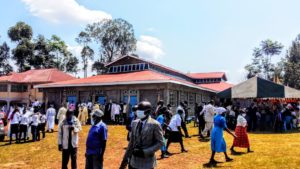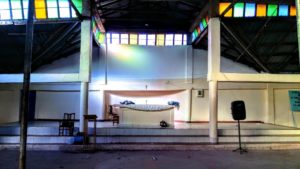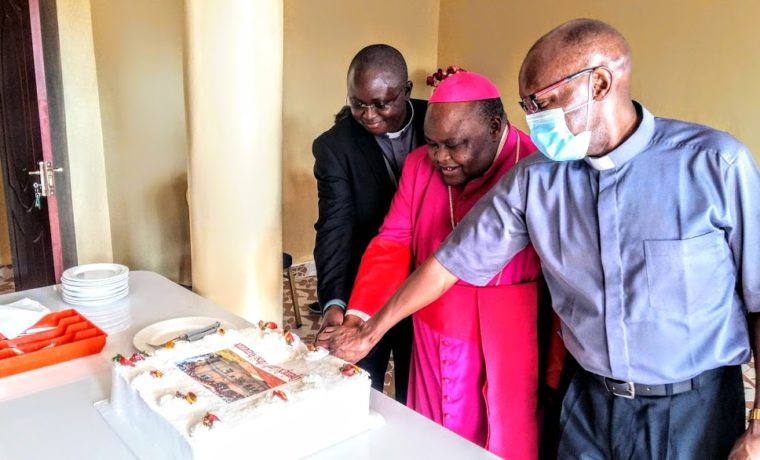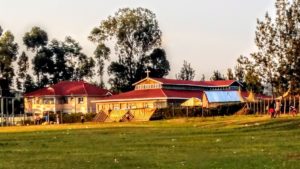On 5 September 2020 we took responsibility for a new parish: it is called the St. Camillus Nyamarambe Catholic Parish. Its name comes from the small town of Nyamarambe which is three kilometres from the hospital of Tabaka. If we had not been present in Tabaka over the last forty-four years, we would never have received such a gift. The parish of Nyamarambe, in fact, was given to us by the diocese of Kisii in recognition of our faithful and long-lasting work performed over all these years. The Bishop of Kissi, Msgr. Joseph Mairura Okemwa, given that he had to divide the parish of Tabaka into two parts because it had become too large, thought that there could not be a more worthy institute than that of the Camillians to which to entrust this new parish.
A parish with seventeen churches
The inauguration took place at the hands of the bishop himself and during this inauguration the church was blessed. However, its construction has not yet been fully completed. The parish house was also officially opened and blessed. In addition, the new parish priest was installed – the Camillian, Fr. Reauben Njagi Kawai. During the course of the celebration of the Eucharist, at which hundreds of people and various politicians of the area took part, the Provincial Delegate, Fr. Dominic Mwanzia, wanted to make clear that this new parish did not belong to Bishop Msgr. Mairura and not even to the parish priest, but to the Camillians. He did this to emphasise that it was the community of Tabaka – and thus the Camillians in Kenya – who had taken on the task of meeting the various needs of the people of God who in a juridical sense belong to the Parish of St. Camillus.
We do not know exactly how many parishioners there are. However, we know that the mother parish is made up of seventeen out-stations, that is to say satellite churches, whose number give us an idea of the territory of the parish, as well as the population density (which is the highest in the whole of the country). The faithful are happy to belong to this new parish because now the number of kilometres that have to be travelled to reach the mother  church have been notably reduced compared to what was previously the situation.
church have been notably reduced compared to what was previously the situation.
The Camillian parish ministry
To support this choice of a Camillian ministry, which was agreed upon by our confreres at a general assembly that took place a year ago, it should be said that this parish can, quite rightly, be seen as the offspring of the hospital of Tabaka and, as was emphasised by the Delegate Fr. Domenic, it will be run by the community of Tabak. In addition, it should be said that to preserve its pastoral nature of service to the sick, the parish can take responsibility for the chaplain of the state hospital that is located 300 metres from the church.
Of the other parishes managed by the Delegation of Kenya, two are involved in health-care activities: the Parish of Our Lady Help of Christians in Ndundu, which is responsible for a health centre, and the Parish of St. Peter in Kwihota, which for now manages a dispensary with a view to establishing a health centre inside the boundaries of the parish. These two parishes form a part of the Archdiocese of Nairobi and are in the hinterland of the capital city of Kenya.
The other parish run by the Camillians is the St. Camillus de Lellis Parish in Rodi Kopany, located on the road that goes from Tabaka to Karungu, which for the moment does not engage in specific health-care activity. This parish belongs to the Diocese of Homa Bay. In all these four parishes that are administered by the Order of Camillians, there is ample room to perform the Camillian ministry because of the growing number of sick people who  live at home because of a lack of money to pay for hospital treatment or because they have reached the final stage of their illnesses. If we wanted to present a statistical report on the way in which the ministry of the Camillians is performed in Kenya, we would have to say that we work in two works of ours (Tabaka and Karungu) and that we perform the work of chaplains in four hospital chaplaincies and in a university chaplaincy. In a short while the taking of responsibility for another chaplaincy is envisaged – that in a hospital managed by the Diocese of Kisumu.
live at home because of a lack of money to pay for hospital treatment or because they have reached the final stage of their illnesses. If we wanted to present a statistical report on the way in which the ministry of the Camillians is performed in Kenya, we would have to say that we work in two works of ours (Tabaka and Karungu) and that we perform the work of chaplains in four hospital chaplaincies and in a university chaplaincy. In a short while the taking of responsibility for another chaplaincy is envisaged – that in a hospital managed by the Diocese of Kisumu.
Paolo Guarise
















Camillians on Facebook
Camillians on Twitter
Camillians on Instagram